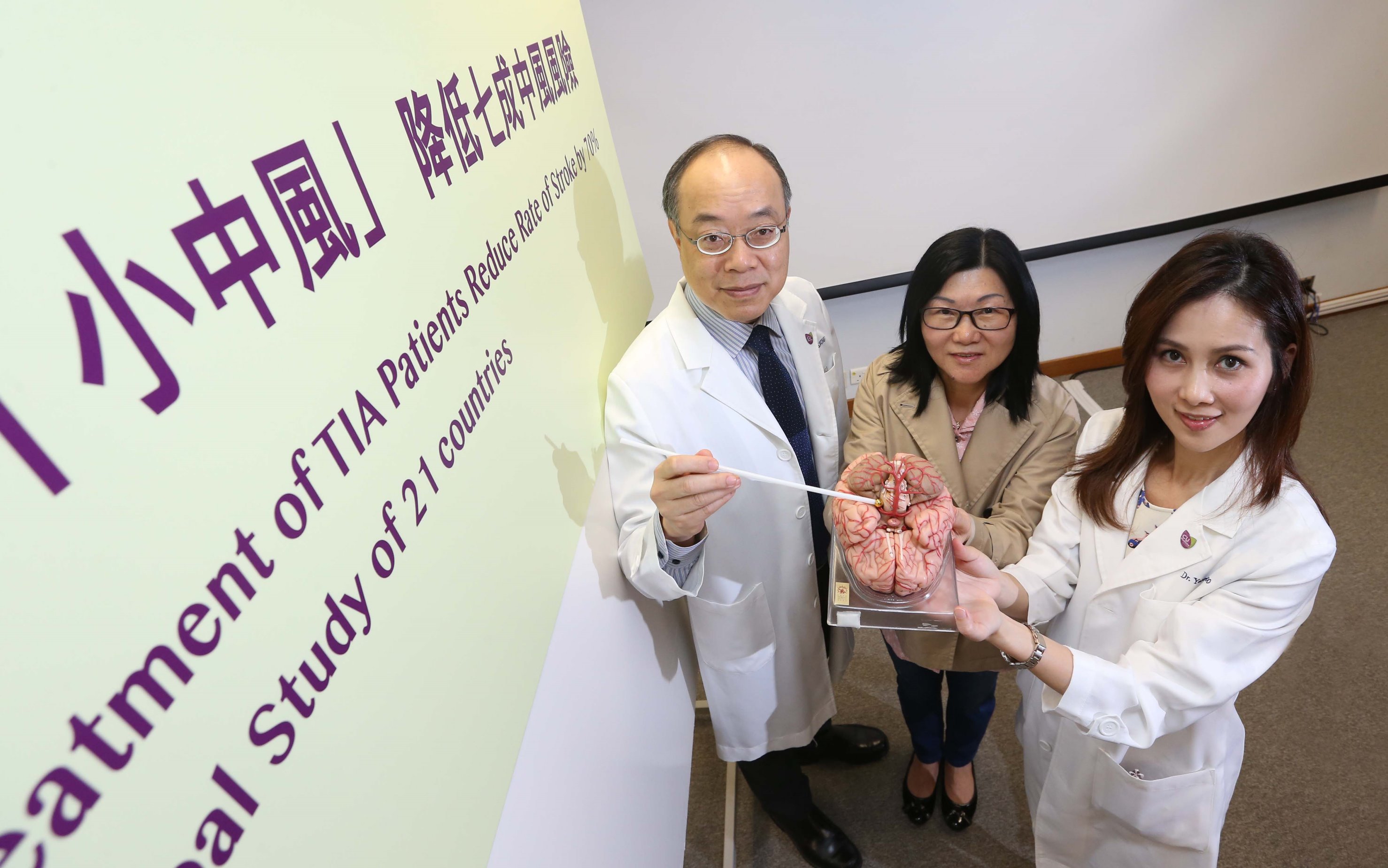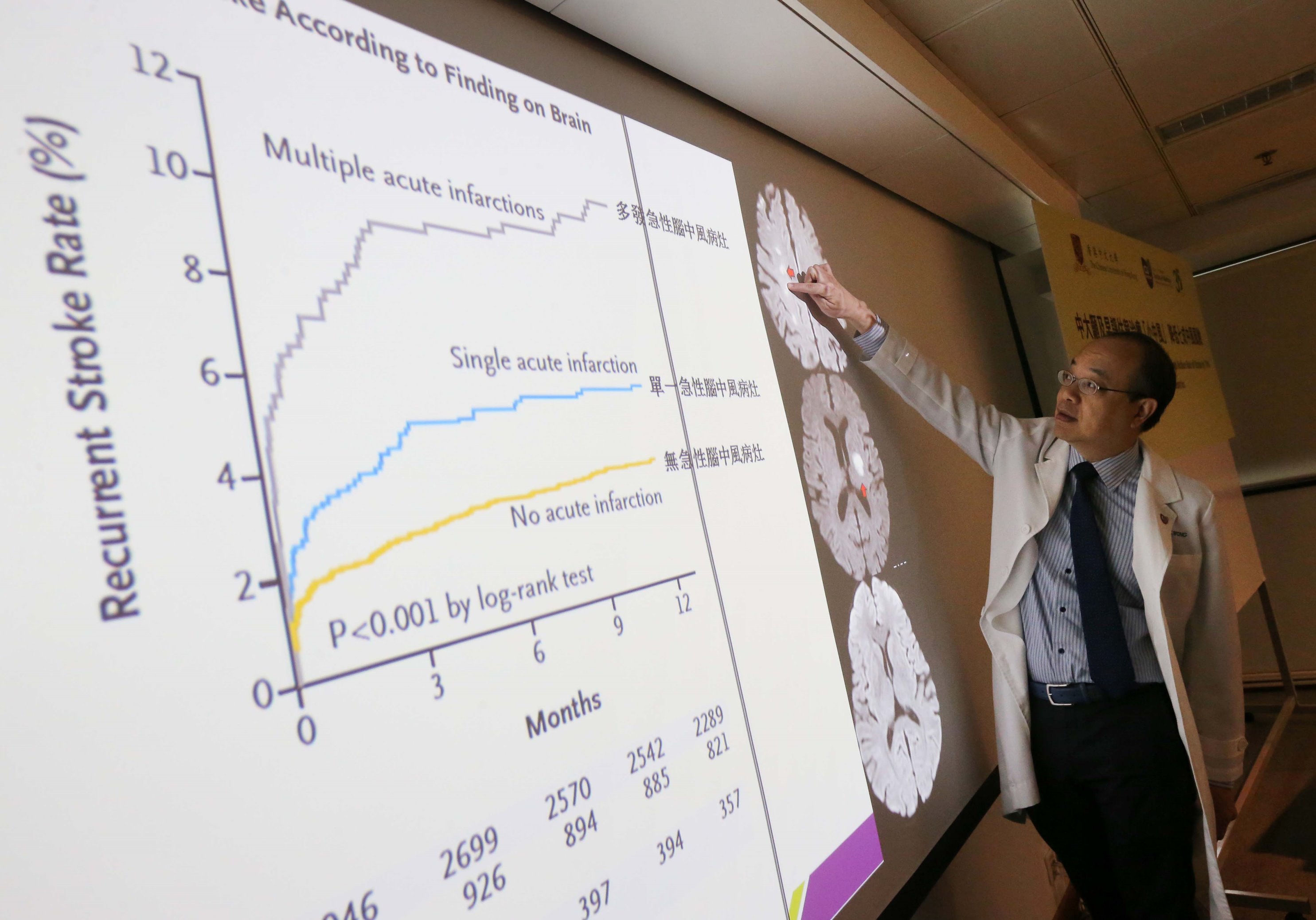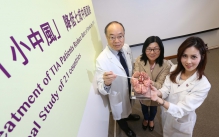CUHK
News Centre
CUHK Sees Early Evaluation of TIA Patients Reduce Rate of Stroke by 70% in a Global Study of 21 Countries
A global study jointly led by The Chinese University of Hong Kong (CUHK) and stroke experts from different countries has revealed that evaluation of Transient Ischemic Attack (TIA) patients by stroke specialists and the start of appropriate treatments within 24 hours of symptoms onset can reduce the rate of stroke by 70%. The data came from 61 specialised centres in 21 countries. The findings are published in a leading international journal, The New England Journal of Medicine, today.
More than 3,000 TIA or mild stroke patients attend HK public hospitals per year
TIA, often labeled as a ‘mini-stroke’, is caused by the temporary blockage of blood vessels in the brain. Dr. Yannie Oi Yan SOO, Clinical Professional Consultant, Department of Medicine and Therapeutics at CUHK, stated, ‘TIA can cause sudden symptoms similar to those of a stroke, such as limb weakness or numbness, facial weakness, speech or visual disturbance. Although the symptoms often last only a few minutes or hours, it can be a warning of a more severe stroke, which can result in permanent neurological deficit or even death.’ About 30% of patients who have a TIA will subsequently develop a more severe form of stroke.
Every year, there are more than 3,000 patients attending public hospitals for TIA or mild stroke in Hong Kong. At the Prince of Wales Hospital, there are 230 cases of suspected TIA and 550 cases of mild stroke per year.
In the past, there was no special arrangement to manage patients with TIA or minor stroke. The risk of stroke after TIA was very high: 5% within 7 days and 12% within 3 months. However, with recent emphasis on managing patients with TIA early, the risk of stroke might be reduced.
TIA may lead to brain cell death, severely narrowed arteries or atrial fibrillation
TIA Registry.org is an international registry of 4,789 patients with TIA in 61 international centres among 21 countries and regions, including 139 patients from the Prince of Wales Hospital in Hong Kong. In this registry, 78% of patients were evaluated by stroke specialists within 24 hours of symptom onset. Imaging of the brain showed 33% of patients had evidence of death of brain cells despite transient or mild symptoms, 23% had at least 1 severely narrowed artery and 10.4% had atrial fibrillation.
The most striking finding of this study was the low rate of stroke after TIA. The stroke rates were 2.1% within 1 week and 3.7% within 3 months, which were much lower than the anticipated rates of 5% and 12% respectively. For the rate of stroke within 3 months after TIA, there was a reduction of around 70% when compared with the anticipated figure.
Prof. Lawrence Ka Sing WONG, Mok Hing Yiu Professor of Medicine, Head of Division of Neurology, Department of Medicine and Therapeutics at CUHK, remarked, ‘If we can see patients sooner, evaluate the cause of the TIA/minor stroke and start appropriate treatments, preferably within 12-24 hours, the rate of stroke can be much reduced.’ The usual treatment consists of antiplatelet drugs, statin and antihypertensive agents. Brain scan, imaging of the vessels to the brain and electrocardiogram (ECG) are important investigations, which help doctors to choose specific treatments for the underlying conditions.
Prof. Wong recommended the public to raise awareness on different severe form of stroke and remember the slogan ‘ACT F.A.S.T’ :
- Face Drooping – Does one side of the face droop or is it numb? Ask the person to smile. Is the person’s smile uneven?
- Arm Weakness – Is one arm weak or numb? Ask the person to raise both arms. Does one arm drift downward?
- Speech Difficulty – Is speech slurred? Is the person unable to speak or hard to understand? Ask the person to repeat a simple sentence, like “The sky is blue.” Is the sentence repeated correctly?
- Time to call 999 – If someone shows any of these symptoms, even if the symptoms go away, call 999 and get the person to the hospital immediately.
A global study jointly led by CUHK and other stroke experts has revealed that evaluation and treatment of TIA patients by stroke specialists within 24 hours of symptoms onset can reduce the rate of stroke by 70%. (From left) Prof. Lawrence WONG, Head of Division of Neurology, Department of Medicine and Therapeutics; TIA case Madam CHAN; and Dr. Yannie SOO, Clinical Professional Consultant, Department of Medicine and Therapeutics, CUHK.
Dr. Yannie SOO, Clinical Professional Consultant, Department of Medicine and Therapeutics states that TIA can be a warning of a more severe stroke.
Prof. Lawrence WONG, Head of Division of Neurology, Department of Medicine and Therapeutics points out early investigations including imaging of brain vessels and electrocardiogram, can reduce the risk of different severe forms of stroke of TIA patients.











